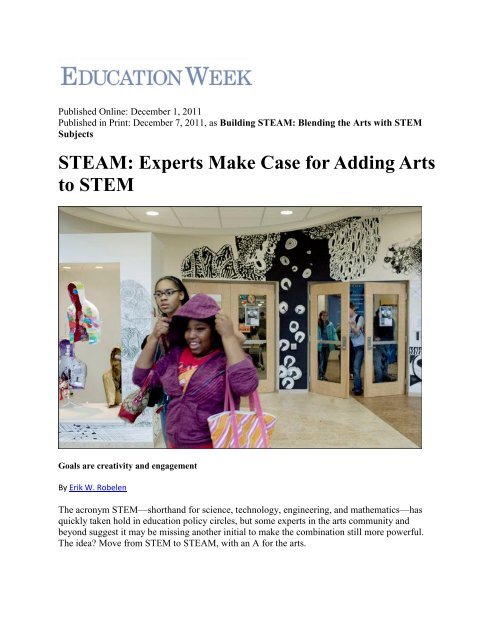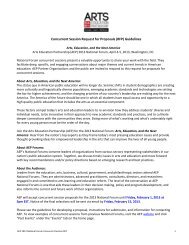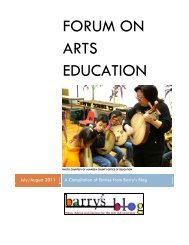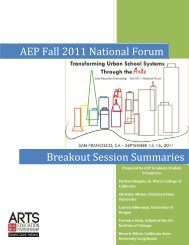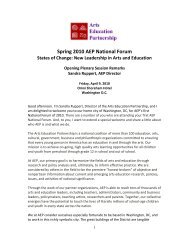STEAM: Experts Make Case for Adding Arts to STEM
STEAM: Experts Make Case for Adding Arts to STEM
STEAM: Experts Make Case for Adding Arts to STEM
You also want an ePaper? Increase the reach of your titles
YUMPU automatically turns print PDFs into web optimized ePapers that Google loves.
Published Online: December 1, 2011<br />
Published in Print: December 7, 2011, as Building <strong>STEAM</strong>: Blending the <strong>Arts</strong> with <strong>STEM</strong><br />
Subjects<br />
<strong>STEAM</strong>: <strong>Experts</strong> <strong>Make</strong> <strong>Case</strong> <strong>for</strong> <strong>Adding</strong> <strong>Arts</strong><br />
<strong>to</strong> <strong>STEM</strong><br />
Goals are creativity and engagement<br />
By Erik W. Robelen<br />
The acronym <strong>STEM</strong>—shorthand <strong>for</strong> science, technology, engineering, and mathematics—has<br />
quickly taken hold in education policy circles, but some experts in the arts community and<br />
beyond suggest it may be missing another initial <strong>to</strong> make the combination still more powerful.<br />
The idea? Move from <strong>STEM</strong> <strong>to</strong> <strong>STEAM</strong>, with an A <strong>for</strong> the arts.
Although it seems a stretch <strong>to</strong> imagine <strong>STEM</strong> will be replaced in education parlance, momentum<br />
appears <strong>to</strong> be mounting <strong>to</strong> explore ways that the intersection of the arts with the <strong>STEM</strong> fields can<br />
enhance student engagement and learning, and even help unlock creative thinking and<br />
innovation.<br />
In fact, federal agencies, including the U.S. Department of Education and the National Science<br />
Foundation, are helping <strong>to</strong> fuel work in those areas.<br />
The NSF has provided research grants and underwritten a number of conferences and workshops<br />
around the nation this year, including a <strong>for</strong>um hosted by the prestigious Rhode Island School of<br />
Design, titled “Bridging <strong>STEM</strong> <strong>to</strong> <strong>STEAM</strong>: Developing New Frameworks <strong>for</strong> Art-Science-<br />
Design Pedagogy.”<br />
Picking up on the Rhode Island institution’s push <strong>for</strong> <strong>STEAM</strong>, in late September, a lawmaker<br />
from that state, U.S. Rep. James Langevin, a Democrat, introduced a House resolution <strong>to</strong><br />
highlight how “the innovative practices of art and design play an essential role in improving<br />
<strong>STEM</strong> education and advancing <strong>STEM</strong> research.”<br />
On-the-ground examples of bringing the arts and <strong>STEM</strong> learning <strong>to</strong>gether abound, from<br />
Philadelphia and San Diego <strong>to</strong> Day<strong>to</strong>n, Ohio.<br />
For instance, the Philadelphia <strong>Arts</strong> in Education Partnership, with support from a $1.1 million<br />
Education Department grant, is working with city schools <strong>to</strong> help elementary students better<br />
understand abstract concepts in science and mathematics, such as fractions and geometric shapes,<br />
through art-making projects.<br />
High school students in several U.S. cities, meanwhile, compete <strong>for</strong> an annual ArtScience Prize.<br />
First launched in Bos<strong>to</strong>n in 2008, the contest fuses concepts in the arts and design with the<br />
sciences. The theme of last school year’s curriculum and contest was the Future of Water. This<br />
year, it’s Virtual Worlds, and next, the emerging field of synthetic biology.<br />
One advocate of the <strong>STEM</strong> <strong>to</strong> <strong>STEAM</strong> push is Harvey Seifter, the direc<strong>to</strong>r of the Art of Science<br />
Learning, a project financed by an NSF grant that organized three conferences last spring in<br />
Washing<strong>to</strong>n, Chicago, and San Diego that brought <strong>to</strong>gether scientists, artists, and researchers, as<br />
well as educa<strong>to</strong>rs, business leaders, and policymakers <strong>to</strong> explore how the arts can be engaged <strong>to</strong><br />
strengthen <strong>STEM</strong> learning and skills and produce a more creative American work<strong>for</strong>ce.<br />
“For me, it is about connecting—or reconnecting—the arts and sciences in ways that learning<br />
can happen at the intersection of the two,” said Mr. Seifter, an expert in arts-based learning who<br />
also consults with Fortune 500 companies on fostering business creativity. “We believe there is a<br />
powerful opportunity here <strong>to</strong> use the arts and arts-based learning <strong>to</strong> spark trans<strong>for</strong>mational<br />
change in science education.”<br />
One core idea Mr. Seifter and other <strong>STEAM</strong> advocates emphasize is that the arts hold great<br />
potential <strong>to</strong> foster creativity and new ways of thinking that can help unleash <strong>STEM</strong> innovation.
“There is creativity in <strong>STEM</strong> itself, super genius in it, ... but in arts education, it really is the<br />
raison d’etre <strong>to</strong> be out of the box, <strong>to</strong> accept the chaos,” said John Maeda, the president of the<br />
Rhode Island School of Design, in Providence.<br />
Artists and designers, he said, are “risk takers, they can think around corners.”<br />
Mr. Maeda invokes <strong>STEAM</strong> as a pathway <strong>to</strong> enhance U.S. economic competitiveness, citing as<br />
an example the late Apple co-founder, Steve Jobs, a leading <strong>for</strong>ce behind the iPod, iPhone, and<br />
other electronic devices.<br />
“What <strong>STEAM</strong> means, it should feel like Steve Jobs, what he did <strong>for</strong> America,” Mr. Maeda said.<br />
“It is an innovation strategy <strong>for</strong> America.”<br />
In da Vinci’s Footsteps<br />
To be sure, the idea of integrating the arts with learning in other fields, including the stem<br />
disciplines, is not new. In fact, some observers have noted an increase of late in activity more<br />
broadly <strong>to</strong> promote arts integration across the curriculum, at a time when the arts struggle <strong>to</strong> keep<br />
a foothold in classrooms amid school budget cuts and the pressure <strong>for</strong> academic gains in core<br />
subjects like reading and math. ("Schools Integrate Dance In<strong>to</strong> Lessons," Nov. 17, 2010.)<br />
But some experts perceive a special connection between the arts and the <strong>STEM</strong> fields. Mr.<br />
Seifter, <strong>for</strong> instance, points <strong>to</strong> a 2008 study led by Robert Root-Bernstein of Michigan State<br />
University, which found that Nobel laureates in the sciences were 22 times more likely than<br />
scientists in general <strong>to</strong> be involved in the per<strong>for</strong>ming arts. Others note that Albert Einstein was<br />
an accomplished violinist. And then there’s the Renaissance figure who some view as the<br />
personification of <strong>STEAM</strong>: Leonardo da Vinci, the Italian painter and sculp<strong>to</strong>r who also made a<br />
name <strong>for</strong> himself as a scientist, engineer, and inven<strong>to</strong>r.<br />
Whether integrating the arts with <strong>STEM</strong> education enhances student learning is not exactly a<br />
settled matter, as even advocates like Mr. Seifter are quick <strong>to</strong> acknowledge.<br />
“There is no question, <strong>to</strong> me, the critical missing piece is the data,” said Mr. Seifter. He adds that<br />
even as he’s witnessed the power of the intersection, he sees a critical need <strong>for</strong> a “solid body of<br />
empirical knowledge about what the arts bring <strong>to</strong> the <strong>STEM</strong> equation.”<br />
Indeed, research examining the effect of arts integration on student achievement across academic<br />
disciplines appears <strong>to</strong> show mixed results.<br />
Leaving the research question aside, however, some experts s<strong>to</strong>p short of embracing a change<br />
from <strong>STEM</strong> <strong>to</strong> <strong>STEAM</strong>.<br />
Alan J. Friedman, a <strong>for</strong>mer head of the New York Hall of Science, said it’s crucial <strong>for</strong> students<br />
not <strong>to</strong> lose sight of the differences, <strong>for</strong> example, between art and science.
“One crucial point at which they part ways is the act of deciding, ‘Is it good art? Is it good<br />
science?’ ” said Mr. Friedman, a member of the National Assessment Governing Board who<br />
holds a doc<strong>to</strong>rate in physics. “Science and art have a lot <strong>to</strong> learn from each other, a lot of<br />
inspiration <strong>to</strong> share, a lot of commonality. They also have some very essential differences that<br />
are at the core of what they are, which is why I have trouble with <strong>STEAM</strong>.”<br />
Susan R. Singer, a biology professor at Carle<strong>to</strong>n College in Northfield, Minn., echoes the point.<br />
“Not <strong>to</strong> devalue the symmetry, but they are very different ways of knowing the world,” said Ms.<br />
Singer, who previously served on the National Research Council’s Board on Science Education.<br />
“I would s<strong>to</strong>p short of <strong>STEAM</strong>, but celebrate the ways that they work <strong>to</strong>gether.”<br />
‘Fraction Mural’<br />
What the intersection of the arts with <strong>STEM</strong> learning looks like in practice varies widely.<br />
The Philadelphia <strong>Arts</strong> in Education Partnership is focused on math and science instruction in the<br />
elementary grades, with support coming from its four-year grant from the Education<br />
Department’s <strong>Arts</strong> in Education Model Development and Dissemination program. For example,<br />
through art-making projects, students at one school manipulated the abstract concepts underlying<br />
fractions <strong>for</strong> a more concrete understanding of how they work. The students even created a<br />
“fraction mural” displayed at the school.<br />
“We match arts skills and processes <strong>to</strong> a specific learning goal in math and science,” said Raye<br />
Cohen, the education direc<strong>to</strong>r at the Philadelphia arts group.<br />
She said that work with the visual arts is especially promising. “Visual arts just seems <strong>to</strong> really<br />
be able <strong>to</strong> home in on the concept, taking it from the abstract <strong>to</strong> the concrete, so students are<br />
really able <strong>to</strong> understand it,” she said.<br />
Ms. Cohen says the project involves an “intense research component” and will look at a variety<br />
of effects, including student test scores and suspensions and unexcused absences, as well as<br />
parent engagement in homework and changes in teaching practices.<br />
In Cali<strong>for</strong>nia, a $1.1 million grant last year by Cali<strong>for</strong>nia’s Postsecondary Education<br />
Commission, using federal teacher-quality aid, is supporting the 134,000-student San Diego<br />
school district’s work linking arts learning with science in grades 3-5.<br />
“It’s not just teaching science through the arts, but teaching science and the art <strong>to</strong>gether, and<br />
what comes from that is more than either of them standing alone,” said Karen Childress-Evans,<br />
the district’s direc<strong>to</strong>r of visual and per<strong>for</strong>ming arts.<br />
The Wolf Trap Foundation <strong>for</strong> the Per<strong>for</strong>ming <strong>Arts</strong>, based in Vienna, Va., has recently developed<br />
early-childhood initiatives that blend <strong>STEM</strong> learning with the arts. The work—supported in one<br />
instance by a 2010 federal Education Department grant, in another by the philanthropic arm of
aerospace giant Northrop Grumman—involves per<strong>for</strong>ming artists in theater, music, dance, and<br />
puppetry working alongside classroom teachers in preschool and kindergarten settings.<br />
The ArtScience Prize, working primarily with high school students, is built around the ideas of<br />
Harvard University professor David A. Edwards, the author of ArtScience: Creativity in the<br />
Post-Google Generation. Students typically work in small teams on projects across a year’s time<br />
in an after-school or in-school setting. The program has quickly expanded beyond Bos<strong>to</strong>n <strong>to</strong><br />
include Minneapolis and Oklahoma City, as well as international locations.<br />
The winning team in Oklahoma City earlier this year developed a biodegradable water bottle,<br />
while the <strong>to</strong>p-rated Bos<strong>to</strong>n team is creating public art installations that communicate how people<br />
around the world struggle <strong>to</strong> gain access <strong>to</strong> fresh water.<br />
“We’re empowering young people <strong>to</strong> come up with their own ideas while exploring and playing<br />
in the arts and science,” said Carrie Fitzsimmons, the executive direc<strong>to</strong>r of ArtScience Labs, the<br />
Cambridge, Mass.-based organization that manages the ArtScience Prize. “It’s all fun,<br />
experiential learning, but we’re teaching them <strong>to</strong> be critical thinkers and problem-solvers.”<br />
Meanwhile, a Georgia charter school with a self-described <strong>STEAM</strong> focus won a $1 million state<br />
grant this summer. The grant, part of the state’s Race <strong>to</strong> the Top award, will further the school’s<br />
work in connecting the disciplines through professional development and provide outreach so the<br />
campus can serve as a demonstration site.<br />
“We want <strong>to</strong> make <strong>STEAM</strong> a model <strong>for</strong> other schools ... all around our state,” Gov. Nathan Deal,<br />
a Republican, said in announcing the grant, according <strong>to</strong> the Atlanta Journal-Constitution.<br />
In Ohio, the Day<strong>to</strong>n Regional <strong>STEM</strong> School takes the integration of subjects, including the arts,<br />
seriously.<br />
Art teacher Jenny Montgomery said her colleagues in other disciplines often approach her about working<br />
<strong>to</strong>gether. Last month, <strong>for</strong> instance, she team-taught with a biology teacher as part of a project in which<br />
students made watercolor paintings of cells.<br />
“We were studying cell structure,” she said, “and we were looking at paintings [the students<br />
created] ..., these beautiful artistic renderings, and students could pick out the structures that they<br />
had been studying.”<br />
Ms. Montgomery said her work with science teachers has helped her make connections between<br />
the disciplines.<br />
“One thing we looked at ... was how artists and scientists have common methodologies in<br />
observing the world around them,” she said.<br />
At the same time, Ms. Montgomery said, even in a <strong>STEM</strong> school, it’s important <strong>for</strong> art not<br />
simply <strong>to</strong> be valued <strong>for</strong> its application <strong>to</strong> other disciplines.
“I also uphold the value of making art <strong>for</strong> art’s sake,” she said, “that students have an<br />
opportunity just <strong>to</strong> engage in art <strong>for</strong> the sheer joy of it.”<br />
Coverage of leadership, expanded learning time, and arts education is supported in part by a<br />
grant from The Wallace Foundation, at www.wallacefoundation.org.<br />
Web Only


